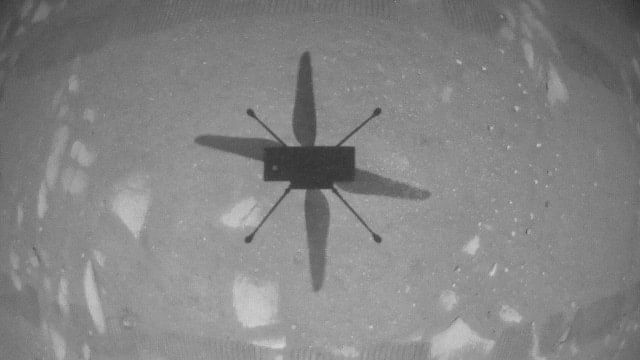
The shadow of NASA's Mars helicopter Ingenuity is seen during its first flight on the planet April 19, 2021.
Credit: Reuters Photo
Ingenuity, the little Mars helicopter that could, can’t anymore.
At least one rotor broke during the robotic flying machine’s most recent flight last week, NASA officials announced Thursday. Ingenuity remains in contact with its companion, the Perseverance rover, which has been exploring a dried-up riverbed for signs of extinct Martian life.
Ingenuity will now be left behind.
“It is bittersweet that I must announce that Ingenuity, the little helicopter that could — and it kept saying, ‘I think I can, I think I can’ — well, it has now taken its last flight on Mars,” said Bill Nelson, the NASA administrator.
Ingenuity arrived on Mars in the undercarriage of the Perseverance rover in February 2021. The helicopter was a late addition to the mission, providing important lessons for future mission designers during its 72 flights through the planet’s thin atmosphere.
“They can rely on what we’ve accomplished,” said Theodore Tzanetos, the Ingenuity project manager. “They can point to the fact that a cellphone processor from 2015 can survive the radiation environment on Mars for 2 1/2 years. Lithium-ion battery cells that are commercial, off the shelf, can survive for 2 1/2 years, Those are massive victories for engineers around NASA.”
On April 19, 2021, Ingenuity became the first plane or helicopter to take off on another planet, the aircraft’s rotors spinning 2,400 times a minute to generate sufficient lift in an atmosphere that is only one one-hundredth as dense as Earth’s.
The plan then was to conduct a demonstration of the novel technology: five flights in 30 days. Perseverance was then to leave Ingenuity behind and begin studying ancient sedimentary rocks along the rim of the Jezero crater, which held a lake of water several billion years ago.
Ingenuity aced the five flights, and it worked so well that mission managers decided to bring the helicopter along to scout the terrain ahead of the rover. Over the next thousand days, Ingenuity continued to go up and down, up and down. It experienced glitches along the way, making three emergency landings. It survived dust storms and the cold Martian winter, which the aircraft was not designed for. Engineers upgraded its software so that Ingenuity could choose its own landing sites.
“It’s almost an understatement to say that it has surpassed expectations,” said Lori Glaze, NASA’s associate administrator for the science directorate.